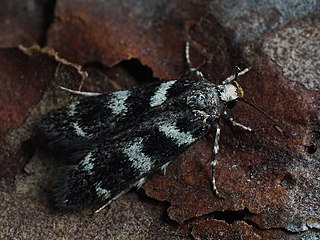
Cladonia is a genus of moss-like lichens in the family Cladoniaceae. They are the primary food source for reindeer/caribou. Cladonia species are of economic importance to reindeer-herders, such as the Sami in Scandinavia or the Nenets in Russia. Antibiotic compounds are extracted from some species to create antibiotic cream. The light green species Cladonia stellaris is used in flower decorations.

Acronicta rumicis, the knot grass moth, is a species of moth which is part of the genus Acronicta and family Noctuidae. It was first described by Carl Linnaeus in his 1758 10th edition of Systema Naturae. It is found in the Palearctic region. A. rumicis lives and feeds on plants located in wide-open areas. At its larval stage, as a caterpillar, it causes such a large impact as a crop pest that it has received much attention and research. A. rumicis feeds on maize, strawberries and other herbaceous plants.

The spring oak leafroller is a moth of the family Gelechiidae. It is found in North America from Nova Scotia to south-western Manitoba, south to Florida.

Parapoynx fluctuosalis or Fluctuating China-mark or Waved China-mark, is a moth of the family Crambidae. It is a widespread species, known from Africa, India, Sri Lanka, China, Japan, Malaysia, Taiwan, Guam, Hawaii, Fiji, Australia and the Galápagos Islands. It is also an introduced species in Europe, where it has been recorded from Great Britain, the Iberian Peninsula and Sardinia.

Spilonota laricana is a moth of the family Tortricidae. It is found in most of Europe, China, Japan, Russia and the Nearctic realm.

Loxostege turbidalis is a species of moth in the family Crambidae. It was described by Treitschke in 1829. It is found in most of Europe, except Ireland, Great Britain, Norway, the Benelux and the Iberian Peninsula. It has also been recorded from Russia, Turkey, China and Japan.

Argolamprotes micella, the bright neb, is a moth of the family Gelechiidae. It is found in most of Europe, except Ireland, the Iberian Peninsula and most of the Balkan Peninsula. Outside of Europe, it is known from Siberia, the Russian Far East, the southern Kuril Islands and Japan. The habitat consists of hedgerows, open woodland and gardens.

Caryocolum junctella is a moth of the family Gelechiidae. It is found from most of Europe east to China and Japan.

Chionodes distinctella, the eastern groundling, is a moth of the family Gelechiidae. It is found in almost all of Europe, as well as most of Russia, Kazakhstan, Central Asia and North Africa. The habitat consists of dry, rocky heath and meadows and the verges and rough pastures.

Chionodes electella is a moth of the family Gelechiidae. It is found in almost all of Europe. In the east, the range extends to the southern Ural.

Chionodes fumatella, the downland groundling, is a moth of the family Gelechiidae. It is found in almost all of Europe. Outside of Europe, it is found in Turkey, the Caucasus, Mongolia and from Siberia to the Russian Far East.

Chionodes ignorantella is a moth of the family Gelechiidae. It is found in Denmark, Germany, the Czech Republic, Poland, Hungary, Estonia, Latvia, Norway, Sweden, Finland and Russia.

Chionodes luctuella is a moth of the family Gelechiidae. It is found in Norway, Sweden, Finland, Denmark, Germany, Austria, Switzerland, Italy, the Czech Republic, Slovakia, Poland, Hungary, Romania, Estonia, Latvia, Ukraine and Russia.

Chionodes lugubrella is a moth of the family Gelechiidae. The geographical distribution of this species extends throughout Europe, into the Caucasus, Siberia and the Russian Far East. It is also found in North America.
Chionodes praeclarella is a moth of the family Gelechiidae. It is found in most of North America. It also is found in Europe, where the range is limited to Austria, Switzerland and Italy.

Chionodes viduella is a moth of the family Gelechiidae. It is found in France, Germany, Austria, Switzerland, Italy, the Czech Republic, Slovenia, Poland, Bulgaria, Norway, Sweden, Finland, the Baltic region and Russia. It is also found in northern North America, from Alaska to Maine.

Chionodes tragicella is a moth of the family Gelechiidae. It is found in the Netherlands, Belgium, France, Germany, Denmark, Switzerland, Austria, Slovenia, Italy, Hungary, Slovakia, the Czech Republic, Poland, Sweden, Finland and Russia. Outside of Europe, it has been reported from Transbaikal and Tuva.

Cochylidia subroseana, the dingy roseate conch, is a moth of the family Tortricidae. It was described by Adrian Hardy Haworth in 1811. It is found from most of Europe to China, Russia, Korea and Japan. It has also been recorded from North America.

Notocelia tetragonana, the square-spot bell, is a species of moth of the family Tortricidae. It is found in China, Russia and Europe, where it has been recorded from most of the continent, except the Iberian Peninsula, the Netherlands, Denmark and most of the Balkan Peninsula. The habitat consists of woodland and scrubland.
Chionodes pereyra is a moth in the family Gelechiidae. It is found in North America, where it has been recorded from Massachusetts and Michigan to Florida and Texas.


















